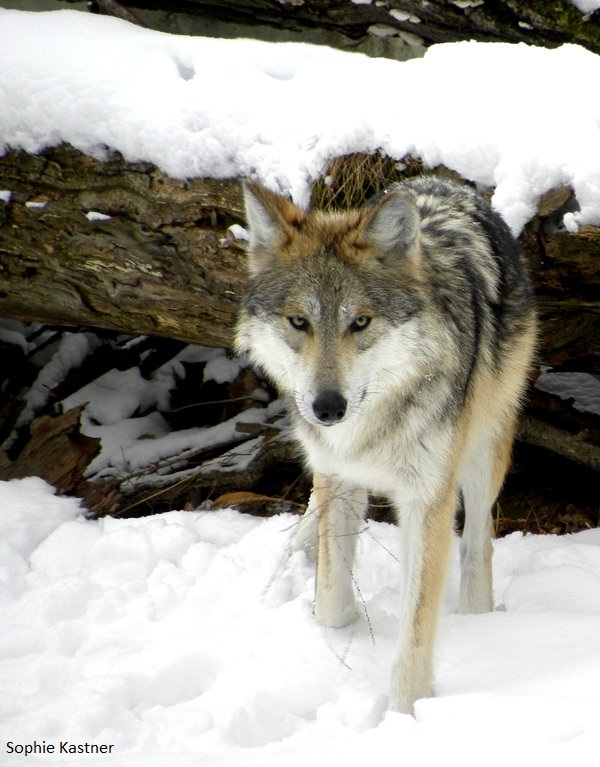Press Release: FWS needs to build on momentum and take further action to increase numbers of Mexican wolves in the wild
 Contact: Kevin Bixby 575-522-5552/575-649-7260 kevin@wildmesquite.org
Contact: Kevin Bixby 575-522-5552/575-649-7260 kevin@wildmesquite.org
LAS CRUCES, NM–Conservationists are encouraged by the small increase in annual Mexican wolf census numbers, but remain concerned about the long-term viability of the population, and renewed calls on U.S. Fish and Wildlife Service (FWS) to take immediate action to remove bureaucratic barriers to releasing more wolves into the wild.
The results of the annual Mexican wolf census conducted by FWS found 58 wolves and 6 breeding pairs at the end of 2011, up from 50 wolves and two breeding pairs a year ago.
“While we’re encouraged by the trend, the overall numbers show that the Mexican wolf remains dangerously close to extinction,” said Kevin Bixby, Executive Director of the Southwest Environmental Center. “FWS needs to build on this momentum. It should immediately initiate a rule change that would allow for direct releases of wolves anywhere in the recovery area, including the Gila National Forest in New Mexico. Boosting the numbers of wild wolves is the only way to prevent this magnificent creature from going extinct.”
The current rule governing the reintroduction project inhibits growth of the wild population by restricting initial releases of captive wolves to the primary recovery zone (PRZ) of the Blue Range Wolf Recovery Area (BRWRA). Wolves are only allowed into the secondary recovery zone (SRZ) if they disperse there on their own, or are translocated for management reasons after first being released in the primary recovery area. The PRZ is located entirely in Arizona and constitutes less than 20 percent of the BRWRA. It does not include any of the Gila National Forest in New Mexico, which contains over 800,000 acres that are roadless and largely cattle free. These areas are well-suited for the initial release of wolves with no prior wild experience.
There was never any biological justification for the current prohibition on direct releases into the secondary recovery area. It was a political decision, plain and simple, made as a concession to wolf opponents. Now that wolves occupy portions of the BRWRA in New Mexico, there is no longer any political justification for it either.
The change is supported by residents living near Mexican wolves, such as business owner Jackie Blurton. “As owner of the KOA in Silver City, I am very interested in the influx of tourism dollars that Mexican wolves would bring in,” she said. “Right now we don’t have a viable, sustainable population to really take advantage of the opportunity to grow our local economy. Because of this, and because of the pressing ecological needs, we must have direct releases into New Mexico.”
Her sentiments are echoed by resident Carol Fugagli, who lives with her family at the edge of the Gila National Forest. “We would welcome the release of more Mexican wolves into the area,” she said. “Much of the reason we moved here was to expose our son to the wonders of Nature, and the addition of more wolves would greatly enhance all of our lives. Whenever we hear the haunting, yet beautiful howl of these wolves, we are reminded of how lucky we are to share the Earth with these enchanting creatures.”
The need to amend the current rule has long been discussed, but has yet to be implemented. FWS reportedly began discussing a rule change to allow for direct releases outside the PRZ as early as 1999. A panel of experts convened by FWS strongly recommended that the Service seek authority to release wolves directly into remote areas in the SRZ, such as the Gila National Forest, to minimize conflicts with humans, dogs and livestock.
In 2001, another team of wolf experts led by Dr. Paul Paquet evaluated the reintroduction program as part of the Three Year Review and recommended that the FWS “immediately modify the final rule and develop the authority to conduct initial releases into the Gila National Forest.” Noting that wolves had already occupied much of the PRZ and that wolves should not be released in areas with resident wolves, the authors stated that this was “by far the most important and simplest change the Service can make to the existing reintroduction project.” They added that using several high-quality release sites in the Gila National Forest “is the best way for improving the cost-effectiveness and certainty of the reintroduction project.”
In 2005, as part of the Five-year Review of the reintroduction project, the Adaptive Management Oversight Committee recommended that FWS “Immediately modify the final rule and develop authority to conduct releases into the Gila National Forest.” The committee noted that the Gila National Forest contained “much of the best wolf habitat, due to existence of areas with low or no road densities, good populations of large native ungulates (primarily elk), and few to no permitted livestock.” AMOC stated that the prohibition on direct releases into the SRZ “restricts the pool of available release candidates and limits AMOC’s ability to release wolves for management purposes, such as replacement of lost mates or genetic augmentation.”
Despite the fact that various groups of experts and stakeholders have been recommending this rule change since 1999, FWS has yet to take action on it. A draft proposed rule change was reportedly developed by FWS in February 2000, but was never released.
Photo courtesy of Sophie Kastner



